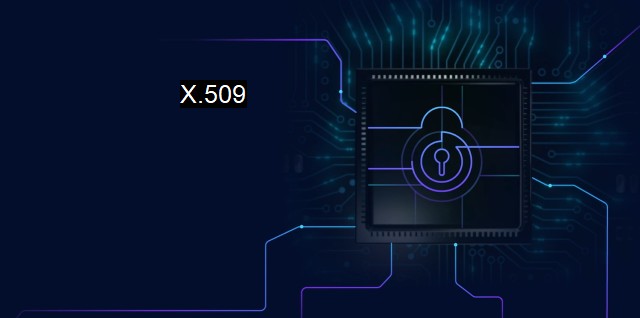What is X.509?
The Vital Role of X.509 Protocol in Ensuring Cybersecurity: Digital Certificate Verification Made Easy with Standard Encodings and Trusted Third-Party Organizations
X.509 is a critical standard used extensively in the realm of cybersecurity and antiviruses. It primarily pertains to the architecture of public key infrastructure (PKI), specifying standard formats for public key certificates, certificate revocation lists, attribute certificates, and a certification path validation algorithm. The core purpose behind X.509 is to allow pathways for secure connections over a network and ensure protected and secure exchanges of information amidst the increasing cybersecurity threats.Originating from the X.500 standard, X.509 has integrated intoal several internet protocols to offer it into a broad selection of applications. The ITU-T (International Telecommunications Union-Telecommunication Standardization Sector), an agency of the United Nations, originally defined the standard based upon the requirements developed by the OSI (Open Systems Interconnection) for a secure and reliable directory service.
In the context of cybersecurity and antivirus software, X.509 plays a significant role. The most common usage of X.509 certificates includes SSL/TLS sessions, which are established between the browser and the server so that the users can ensure an encrypted, secure communication. SSL (Secured Socket Layer) and the path which follows, Transport Layer Security (TLS), is the cornerstone that ensures the security of practically all significant, over-the-network communications.
The X.509 standard requires a hierarchical trust model. This means there exist one or more trusted entities referred to as Certificate Authorities (CAs), which digitally sign and issue certificates to subordinate entities. Either direct or through a chain of trust intermediates, a certificate verifies the ownership of a public key included in it, linking it with the entity’s information to the key’s validity period. Only the CA that issues the certificate can revoke it.
Cybersecurity thrives on the recall of these technological safeguards, similar to X.509 certificates painted in antiviral elements. Antivirus software scans the X.509 certificates to ascertain vulnerabilities and deny malicious prying by the attackers. For instance, if a certificate is untrusted or expired, antivirus software triggers alerts indicating an unsecured connection or warns the user about the situation’s potential security risks.
An Antivirus will frequently check the X.509 digital certificates against its database of various known threats and fraudulent certificates. If an antivirus encounters any suspicious activity or a mismatch, it automatically blocks such interactions, adding an extra layer of security measures. With these certified and encrypted protocols, parties can be authenticated, and data integrity can be checked along with the assurance of secure and encapsulated data transmission.
Due to the incredibly important role it serves in securing network communications, managing and ensuring the protection and authenticity of X.509 certificates is crucial. This has given rise to automated solutions known as Certificate Lifecycle Management, which tools assist in the management of the issuance, renewal, and revocation of a series of digital certificates.
Choices made with X.509 trust management significantly impact the complexity and security of the software environment. On one hand, tailored certificate policies and certificate practice statements enable more focused and secure negotiations to occur. On the other hand, reinforcing trust in a CA signifies lesser end-device configuration, but probably more complex administration on the certificate system. To enhance safety precautions in the system, issuers also keep the revocation listings of certificates and supply them to dependent subjects.
To summarise, the X.509 standard is an essential component of the secure online communication framework. Adopting X.509 certificates advances the structure and protection mechanisms in the face of potential cyber threats. Through the adoption of antivirus software checks alongside X.509 checks, a dual safeguard can be brought forth to optimize online privacy, confidentiality, and security in the dynamic, cyber-threat filled, ever-connected digitized world. Thus, though it is a background player, X.509's relevance in the cybersecurity landscape is vital and unquestionable.

X.509 FAQs
What is an X.509 certificate?
An X.509 certificate is a digital certificate used in cybersecurity to establish the identity of an individual, organization, or device. It contains information such as the name of the entity, its public key, and the name of the issuer.How is an X.509 certificate used in antivirus software?
Antivirus software may use X.509 certificates to verify the authenticity of digital signatures on files. If a file has a valid digital signature, it is more likely to be trustworthy and safe to run on a computer.What is the difference between an X.509 certificate and a SSL/TLS certificate?
An X.509 certificate is a type of SSL/TLS certificate. SSL/TLS certificates also include additional information about a web server or website, including the domain name and IP address, and are used to encrypt communication between a web server and a user's browser.How secure is the X.509 certificate?
An X.509 certificate is a highly secure means of establishing digital identity, as it uses public key cryptography to verify the authenticity of digital signatures. However, like any security measure, it is not foolproof and can be vulnerable to attacks if not implemented correctly or if the private key is compromised.Related Topics
Public Key Infrastructure (PKI) Digital Certificates Transport Layer Security (TLS) Secure Sockets Layer (SSL) Digital Signature
| | A | | | B | | | C | | | D | | | E | | | F | | | G | | | H | | | I | | | J | | | K | | | L | | | M | |
| | N | | | O | | | P | | | Q | | | R | | | S | | | T | | | U | | | V | | | W | | | X | | | Y | | | Z | |
| | 1 | | | 2 | | | 3 | | | 4 | | | 7 | | | 8 | | |||||||